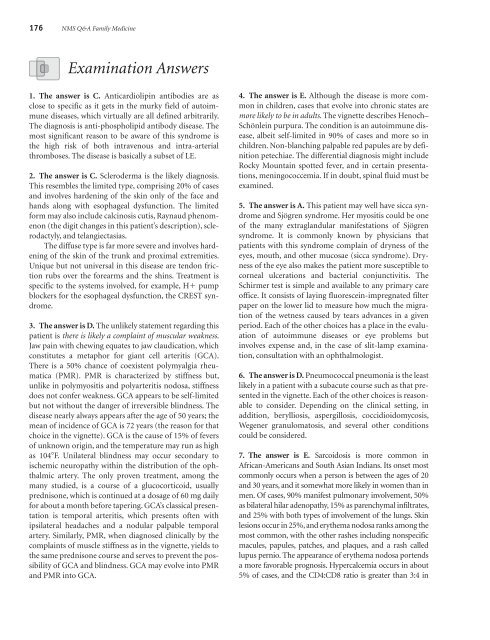NMS Q&A Family Medicine
NMS Q&A Family Medicine
NMS Q&A Family Medicine
- No tags were found...
You also want an ePaper? Increase the reach of your titles
YUMPU automatically turns print PDFs into web optimized ePapers that Google loves.
176 <strong>NMS</strong> Q&A <strong>Family</strong> <strong>Medicine</strong>Examination Answers1. The answer is C. Anticardiolipin antibodies are asclose to specific as it gets in the murky field of autoimmunediseases, which virtually are all defined arbitrarily.The diagnosis is anti-phospholipid antibody disease. Themost significant reason to be aware of this syndrome isthe high risk of both intravenous and intra-arterialthromboses. The disease is basically a subset of LE.2. The answer is C. Scleroderma is the likely diagnosis.This resembles the limited type, comprising 20% of casesand involves hardening of the skin only of the face andhands along with esophageal dysfunction. The limitedform may also include calcinosis cutis, Raynaud phenomenon(the digit changes in this patient’s description), sclerodactyly,and telangiectasias.The diffuse type is far more severe and involves hardeningof the skin of the trunk and proximal extremities.Unique but not universal in this disease are tendon frictionrubs over the forearms and the shins. Treatment isspecific to the systems involved, for example, H pumpblockers for the esophageal dysfunction, the CREST syndrome.3. The answer is D. The unlikely statement regarding thispatient is there is likely a complaint of muscular weakness .Jaw pain with chewing equates to jaw claudication, whichconstitutes a metaphor for giant cell arteritis (GCA).There is a 50% chance of coexistent polymyalgia rheumatica(PMR). PMR is characterized by stiffness but,unlike in polymyositis and polyarteritis nodosa, stiffnessdoes not confer weakness. GCA appears to be self-limitedbut not without the danger of irreversible blindness. Thedisease nearly always appears after the age of 50 years; themean of incidence of GCA is 72 years (the reason for thatchoice in the vignette). GCA is the cause of 15% of feversof unknown origin, and the temperature may run as highas 104 F. Unilateral blindness may occur secondary toischemic neuropathy within the distribution of the ophthalmicartery. The only proven treatment, among themany studied, is a course of a glucocorticoid, usuallyprednisone, which is continued at a dosage of 60 mg dailyfor about a month before tapering. GCA’s classical presentationis temporal arteritis, which presents often withipsilateral headaches and a nodular palpable temporalartery. Similarly, PMR, when diagnosed clinically by thecomplaints of muscle stiffness as in the vignette, yields tothe same prednisone course and serves to prevent the possibilityof GCA and blindness. GCA may evolve into PMRand PMR into GCA.4. The answer is E. Although the disease is more commonin children, cases that evolve into chronic states aremore likely to be in adults . The vignette describes Henoch–Schönlein purpura. The condition is an autoimmune disease,albeit self-limited in 90% of cases and more so inchildren. Non-blanching palpable red papules are by definitionpetechiae. The differential diagnosis might includeRocky Mountain spotted fever, and in certain presentations,meningococcemia. If in doubt, spinal fluid must beexamined.5. The answer is A. This patient may well have sicca syndromeand Sjögren syndrome. Her myositis could be oneof the many extraglandular manifestations of Sjögrensyndrome. It is commonly known by physicians thatpatients with this syndrome complain of dryness of theeyes, mouth, and other mucosae (sicca syndrome). Drynessof the eye also makes the patient more susceptible tocorneal ulcerations and bacterial conjunctivitis. TheSchirmer test is simple and available to any primary careoffice. It consists of laying fluorescein-impregnated filterpaper on the lower lid to measure how much the migrationof the wetness caused by tears advances in a givenperiod. Each of the other choices has a place in the evaluationof autoimmune diseases or eye problems butinvolves expense and, in the case of slit-lamp examination,consultation with an ophthalmologist.6. The answer is D. Pneumococcal pneumonia is the leastlikely in a patient with a subacute course such as that presentedin the vignette. Each of the other choices is reasonableto consider. Depending on the clinical setting, inaddition, berylliosis, aspergillosis, coccidioidomycosis,Wegener granulomatosis, and several other conditionscould be considered.7. The answer is E. Sarcoidosis is more common inAfrican-Americans and South Asian Indians. Its onset mostcommonly occurs when a person is between the ages of 20and 30 years, and it somewhat more likely in women than inmen. Of cases, 90% manifest pulmonary involvement, 50%as bilateral hilar adenopathy, 15% as parenchymal infiltrates,and 25% with both types of involvement of the lungs. Skinlesions occur in 25%, and erythema nodosa ranks among themost common, with the other rashes including nonspecificmacules, papules, patches, and plaques, and a rash calledlupus pernio. The appearance of erythema nodosa portendsa more favorable prognosis. Hypercalcemia occurs in about5% of cases, and the CD4:CD8 ratio is greater than 3:4 in
















